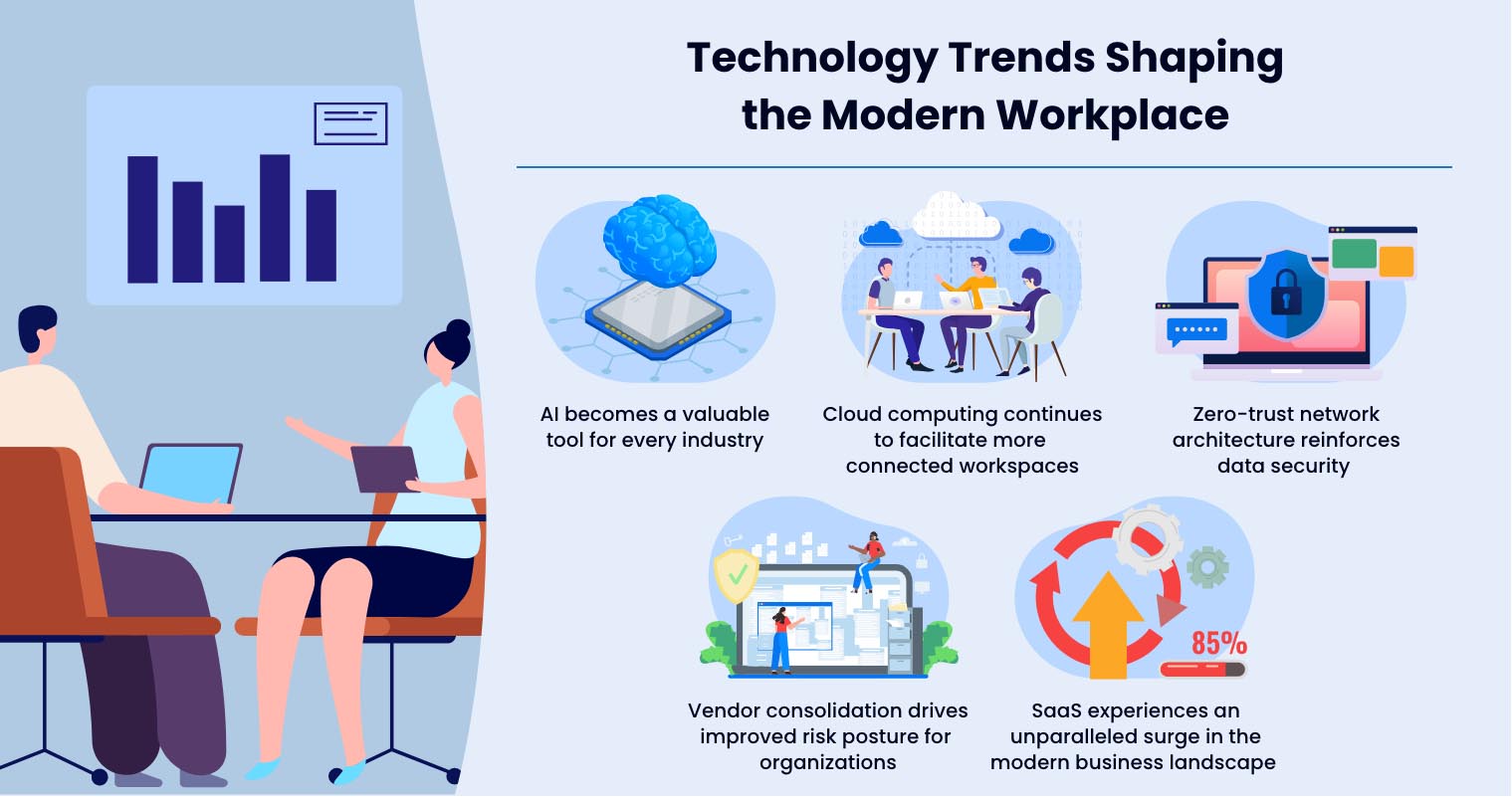Digital transformation has revolutionized the modern workspace, profoundly reshaping how businesses operate and employees navigate their professional lives. This paradigm shift, driven by rapid technological advancements, has empowered organizations globally to optimize productivity, streamline processes, and foster innovation.
From cloud computing and artificial intelligence to remote collaboration and data analytics, the digital revolution has unleashed a myriad of opportunities and challenges for businesses worldwide.
In this guide, we delve into the impact of digital transformation in the business landscape and how it paves the way to a more interconnected and dynamic work environment.
What is Digital Workplace Transformation?
Digital workplace transformation refers to the process of implementing new technologies within an organization to change how work is conducted. The goal is to create a more agile, connected, and efficient work environment that leverages technology to optimize workflows and improve communication.
In this age of disruption, embracing digital transformation is no longer a choice but a necessity for businesses to remain relevant and thrive. It is a catalyst for agility, enabling companies to adapt to evolving market dynamics, anticipate customer needs, and capitalize on emerging opportunities.
However, the transformative power of technology extends beyond organizational boundaries, reshaping entire industries and creating new economic ecosystems.
Key Drivers of Digital Workplace Transformation

Digital workplace transformation is driven by several key factors that shape the need for organizations to adapt and embrace technological advancements. Here are some key drivers:
Growing expectations of consumers
In today’s digital age, consumers have higher expectations for seamless and personalized experiences. They expect businesses to be digitally enabled, providing instant customer support, self-service options, and online shopping. Adopting digital workplace transformation allows businesses to meet these expectations by improving customer engagement, offering omnichannel experiences, and leveraging data analytics to understand and anticipate customer needs.
The need for cost control
Rising expenses, market fluctuations, and economic uncertainties necessitate a strategic focus on cost management. And to remain competitive and financially stable, organizations are compelled to explore ways to optimize their costs. Cost control measures facilitated by digital transformation enable businesses to optimize operational efficiency and enhance financial resilience. Moreover, organizations can better navigate challenging economic conditions and adapt to market changes.
Attracting younger workforce
Millennials and Generation Z make up a significant portion of the workforce and have grown up with technology. These digital natives value a modern and tech-savvy work environment. Adopting a digital workplace transformation helps attract and retain top talent from these generations. Offering flexible work arrangements, collaborative digital tools, and remote work options aligns with the expectations and preferences of younger employees.
Addressing environmental consciousness
With growing concerns about climate change and sustainability, businesses are under pressure to adopt environmentally conscious practices. Digital workplace transformation can contribute to sustainability efforts by reducing the need for physical resources. For example, adopting digital documentation and cloud storage reduces paper usage, while remote work options reduce commuting and associated carbon emissions. Digital technologies also enable energy-efficient operations, such as smart building management systems.
With the evolving digital landscape, businesses are compelled to embrace digital workplace transformation driven by these factors. Now that you know why businesses invest in technology, it’s time to learn what trends are revolutionizing how they work today.
Technology Trends Shaping the Modern Workplace

Every modern organization today seeks to stay on the leading edge of digital trends. Not only to stay competitive in the global market but also to amplify work efficiency and expand operations. So what tech trends are shaping today’s modern workplace, and will continue to impact businesses in the years to come? Find out below.
1. AI becomes a valuable tool for every industry
Artificial Intelligence (AI) continues to transform industries by enabling automation, data analysis, and enhanced decision-making. Conversational AI, powered by natural language processing and machine learning, is being used in customer service, virtual assistants, and chatbots.
Even with the changing workforce structure, experts believe that AI will essentially replace jobs but only leverage a knowledge-based economy for better work. In the recent IDC Worldwide Artificial Intelligence Spending Guide, worldwide spending on AI is expected to surpass $631 billion by 2028.
2. Cloud computing continues to facilitate more connected workspaces
Cloud computing has revolutionized the workplace by offering flexible access to applications, data, and collaboration tools from anywhere, on any device. The cloud enables scalability, cost-effectiveness, and improved collaboration.
One report suggests that cloud computing revenue is expected to reach $623 billion by 2023. And as the global cloud computing market continues to thrive, Gartner states that over 85% of companies will implement a cloud-first principle by 2025. Analysts also suggest that 95% of digital workloads in 2025 will be deployed in cloud-native platforms.
3. Zero-trust network architecture reinforces data security
With the rise in cyber threats, organizations are adopting zero-trust network architectures to strengthen data security. Such architectures reinforce a security policy across all layers through multifactor authentication (MFA) and micro-segmentation.
This approach assumes that no user or device can be trusted by default, reinforcing strict access controls. A recent report suggests that the global zero-trust network market is expected to reach $52 billion by 2026.
4. Vendor consolidation drives improved risk posture for organizations
With the emergence of the API ecosystem that facilitated better software integration, many vendors are now developing unified platforms for better interconnection. Other drivers of vendor consolidation include reduced complexity and cost optimization.
A 2022 Gartner Survey found that 75% of organizations are investing in vendor consolidation to improve security risk posture. By consolidating vendors, organizations can reduce complexity and optimize costs, while enhancing risk management.
5. SaaS experiences an unparalleled surge in the modern business landscape
Software-as-a-Service (SaaS) solutions continue to gain popularity due to their scalability, cost-effectiveness, and ease of use. According to GlobeNewswire, the global SaaS market share is expected to reach $720.44 billion by 2028.
SaaS continues to revolutionize business productivity and efficiency, facilitating low-code platforms and mobile-first solutions. There’s also a higher demand for vertical SaaS solutions, which offer customized tools for specific businesses and industries.
The Benefits of a Modern Digital Workplace

The digital workplace has become an essential part of the modern work experience in many companies. But you might be asking, what’s in it for me? Explore the top digital transformation benefits and how they can upgrade your current workspace.
Improves Productivity and Flexibility
A modern digital workplace provides employees with the tools and technologies necessary to work more efficiently and effectively. It enables them to access information, resources, and applications from anywhere, at any time, using various devices. This flexibility boosts productivity and allows employees to achieve a better work-life balance.
Fosters Creativity and Employee Morale
Digital workplaces often incorporate innovative technologies and collaboration tools that encourage creativity and idea sharing. They provide platforms for brainstorming, knowledge sharing, and team collaboration, fostering a culture of innovation. This, in turn, boosts employee morale and satisfaction, as they feel empowered and engaged in their work.
Enhances Communication and Collaboration
Digital workplace platforms facilitate seamless communication and collaboration among employees, regardless of their physical location. Real-time messaging, video conferencing, file sharing, and project management tools allow teams to work together efficiently, share ideas, and solve problems collectively. Improved communication leads to better teamwork and faster decision-making.
Strengthens Cyber and Information Security
With the increasing prevalence of cyber threats, modern digital workplaces prioritize cybersecurity measures to protect sensitive data and information. They implement robust security protocols, encryption techniques, access controls, and regular system updates to minimize the risk of data breaches and unauthorized access. This ensures the confidentiality, integrity, and availability of critical business data.
Boosts Employee Satisfaction and Retention
A digital workplace empowers employees by providing them with the tools and resources they need to perform their jobs effectively. This leads to higher job satisfaction and improved employee retention rates. Additionally, the flexibility and work-life balance offered by digital workplaces are highly valued by many employees, contributing to their overall job satisfaction.
By embracing digital technologies, companies can harness a range of benefits that drive efficiency, collaboration, and success. But how can your business build a digital workplace that actually offers these perks? Find out in the next section.
Steps in Building a Digital Workplace
Incorporating digital solutions and ensuring a smooth transition requires abundant effort and time from organizations. To help you build a modern workspace effectively, follow the key steps below:
1. Find a catalyst for change
Recognize the need for digital transformation within your organization. Assess pain points, inefficiencies, or emerging market trends that can catalyze change, particularly for traditional organizations that may be resistant. A catalyst could be the need to enhance operational efficiency, meet evolving customer expectations, or address competitive pressures.
2. Have a clear digital workspace vision
Define a clear vision that outlines the desired outcomes of the digital workplace transformation. Determine the goals and benefits you want to achieve from the changes. This vision will guide your digital workplace strategy and decision-making throughout the process.
3. Get the stakeholders involved
Next is to engage key stakeholders, including executives, managers, and employees, in the digital transformation journey. Foster a shared understanding of the digital transformation benefits and importance. Make sure to involve stakeholders in decision-making processes and solicit their input to ensure alignment and ownership.
4. Invest in the right technologies
Identify the digital tools that align with your vision, integration capabilities, budget, and specific business needs. It is best to invest in an all-in-one platform like board management software to get your money’s worth. Such platforms readily offer tools for communication, collaboration, productivity, and data management—all within a single integrated system.
5. Provide proper training to employees
It’s crucial to also equip employees with the skills and knowledge to effectively use the new tools. You can conduct workshops or online tutorials to help employees understand the tools’ functionalities and benefits. In addition, create opportunities for conversations through interactive training sessions or dedicated discussion forums.
6. Get your team’s feedback and act on it
Regularly seek feedback from employees about their experience with the new tools and digital workplace. This can be done through surveys, focus groups, or one-on-one discussions. Act on the feedback by implementing necessary improvements, or providing additional support or training to your staff.
While each digital workplace is unique, organizations are often faced with similar challenges during implementation. These steps can help you ensure the new technology solutions are aligned with your needs, and that everyone on your team is on the same page.
Convene: The Board Portal to Elevate Your Digital Workplace

With tons of digital solutions in the market today, board portals rise to be one of the most useful for transforming business operations. Primarily designed for board meeting management, these tools facilitate secure online platforms for seamless collaboration and improve governance.
Convene, one of the leading board portals today, is designed to elevate digital workplaces with advanced meeting and security features. The platform offers easy access to confidential data, real-time updates, task management capabilities, virtual voting functionality, and more.
Learn more about how Convene can elevate your organization’s current digital workplace. Book a demo now!
Jielynne is a Content Marketing Writer at Convene. With over six years of professional writing experience, she has worked with several SEO and digital marketing agencies, both local and international. She strives in crafting clear marketing copies and creative content for various platforms of Convene, such as the website and social media. Jielynne displays a decided lack of knowledge about football and calculus, but proudly aces in literary arts and corporate governance.











